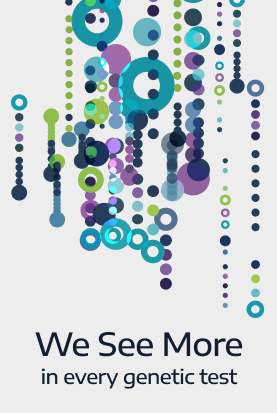
MISSED BY OTHERS, DETECTED BY US
Genomic Unity® Case Study
Clinical presentation
A 54-year-old male with a family history of ALS and dementia presented with the following symptoms:
- Progressive lower leg weakness and spasticity
- Gait imbalance resulting in falls
- Ataxia
Previous genetic testing
Testing was performed for multiple maternal relatives with negative results.

Genomic Unity® Testing
was ordered because of its ability to identify all major variant types in a single test.
Results and interpretation
Variantyx Genomic Unity® testing identified a heterozygous, pathogenic GGGGCC repeat expansion in the C9orf72 gene.
The expansion was confirmed internally using Oxford Nanopore long-read sequencing.
Diagnosis: Frontotemporal dementia and/or amyotrophic lateral sclerosis

A. Uniform data from short-read WGS identifies one normal allele (5 repeats) and one expanded allele. B. Long-read WGS sizes the expanded allele as ~1,600 repeats.
The Variantyx Difference
Why was this variant detected by Genomic Unity® testing, and not detected by other tests?
-
With such general phenotypes, selecting the right targeted test for a patient is impossible and will lead to a long diagnostic odyssey.
Variantyx genome analysis detects all major variant types in a single test including small sequence changes, structural variants, mitochondrial variants, and repeat expansions. This is critical for testing of patients with suspected adult onset neurological disorders. -
When repeat expansions are included in traditional testing, it’s either one gene test or screening testing.
Only Variantyx genome analysis delivers both repeat expansion sensitivity and specificity, using a combination of short and long-read sequencing, when needed, to provide detection and sizing within a single test.
Variantyx tests that would have identified this variant
Genomic Unity® 2.0 | Genomic Unity® Whole Genome Analysis | Genomic Unity® Lightning Genome Analysis | Genomic Unity® Exome Plus Analysis | Genomic Unity® Exome Analysis | Genomic Unity® Movement Disorders Analysis | Genomic Unity® Motor Neuron Disorders Analysis | Genomic Unity® Neuropathies Analysis
Want similar results for your patients?
Connect with a Clinical Specialist to find out how easy it is to bring the power of whole genome sequencing into your practice.
